List of Parliamentary constituencies in Merseyside
The county of Merseyside created in 1974 has 15 Parliamentary constituencies — (sub-classified into 12 of borough type and three of county status affecting the level of expenses permitted and status of returning officer). The area, centred on its largest city of Liverpool, has since that year elected a majority of Labour Party MPs moreover since 1997 at least 13 of 15 seats have been held or won by the party at each general election. The two other largest parties nationally in England have to date won intermittently in the two larger seats within the four in the Wirral, the peninsula facing Liverpool, and best having alternately represented the seat centred on the coastal strip in and around the leisure resort of Southport. The latter town includes Birkdale and Ainsdale beach and has not since the seat was created in 1885 sided with the Labour Party. The bulk of seats especially towards the east and the centre of Liverpool have not sided with the Conservative Party since that party actively supported the National Labour Organisation (1931-1947).
Constituencies
| Constituency[nb 1] | Electorate[1] | Majority[2][nb 2] | Member of Parliament[2] | Nearest opposition[2] | Map | ||
|---|---|---|---|---|---|---|---|
| Birkenhead BC | 63,762 | 17,705 | Mick Whitley‡ | Frank Field (Birkenhead Social Justice) |  | ||
| Bootle BC | 74,832 | 34,556 | Peter Dowd‡ | Tarsilo Onuluk† | 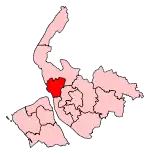 | ||
| Garston and Halewood BC | 76,116 | 31,624 | Maria Eagle‡ | Neva Novaky† |  | ||
| Knowsley BC | 84,060 | 39,942 | George Howarth‡ | Rushi Millns† |  | ||
| Liverpool, Riverside BC | 80,310 | 37,043 | Kim Johnson‡ | Sean Malkeson† | 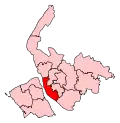 | ||
| Liverpool, Walton BC | 62,628 | 30,520 | Dan Carden‡ | Alex Phillips† |  | ||
| Liverpool, Wavertree BC | 63,458 | 27,085 | Paula Barker‡ | Catherine Mulhern† |  | ||
| Liverpool, West Derby BC | 65,640 | 29,984 | Ian Byrne‡ | Tom Bradley† |  | ||
| Sefton Central CC | 69,760 | 15,122 | Bill Esterson‡ | Wazz Mughal† |  | ||
| Southport BC | 70,837 | 4,147 | Damien Moore† | Liz Savage‡ | 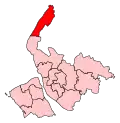 | ||
| St Helens North BC | 75,593 | 12,209 | Conor McGinn‡ | Joel Charles† |  | ||
| St Helens South and Whiston BC | 79,058 | 19,122 | Marie Rimmer‡ | Richard Short† |  | ||
| Wallasey BC | 66,310 | 18,322 | Angela Eagle‡ | James Baker† |  | ||
| Wirral South CC | 57,280 | 6,105 | Alison McGovern‡ | Stewart Gardiner† |  | ||
| Wirral West CC | 55,550 | 3,003 | Margaret Greenwood‡ | Laura Evans† | 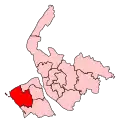 | ||
Constituencies 1997–2010
Proposed boundary changes
The Boundary Commission for England submitted their final proposals in respect of the Sixth Periodic Review of Westminster Constituencies (the 2018 review) in September 2018. Although the proposals were immediately laid before Parliament they were not brought forward by the Government for approval. Accordingly, they did not come into effect for the 2019 election which took place on 12 December 2019, and which was contested using the constituency boundaries in place since 2010.
Under the terms of the Parliamentary Voting System and Constituencies Act 2011, the Sixth Review was based on reducing the total number of MPs from 650 to 600 and a strict electoral parity requirement that the electorate of all constituencies should be within a range of 5% either side of the electoral quota.
On 24 March 2020, the Minister of State for the Cabinet Office, Chloe Smith, issued a written statement to Parliament setting out the Government's thinking with regard to parliamentary boundaries.[3] Subsequently, the Parliamentary Constituencies Act 2020[4] was passed into law on 14 December 2020. This formally removed the duty to implement the 2018 review and set out the framework for future boundary reviews. The Act provided that the number of constituencies should remain at the current level of 650, rather than being reduced to 600, while retaining the requirement that the electorate should be no more than +/- 5% from the electoral quota.
The Act specified that the next review should be completed no later than 1 July 2023 and the Boundary Commission formally launched the 2023 Review on 5 January 2021.[5] See 2023 Periodic Review of Westminster constituencies for further details.
Results history
Primary data source: House of Commons research briefing - General election results from 1918 to 2019[6]
2019
The number of votes cast for each political party who fielded candidates in constituencies comprising Merseyside in the 2019 general election were as follows:
| Party | Votes | % | Change from 2017 | Seats | Change from 2017 |
|---|---|---|---|---|---|
| Labour | 463,371 | 65.2% | 14 | 0 | |
| Conservative | 143,431 | 20.2% | 1 | 0 | |
| Liberal Democrats | 39,591 | 5.6% | 0 | 0 | |
| Brexit | 33,392 | 4.7% | new | 0 | 0 |
| Greens | 19,371 | 2.7% | 0 | 0 | |
| Others | 11,443 | 1.6% | 0.0% | 0 | 0 |
| Total | 710,599 | 100.0 | 15 |
Percentage votes
| Election year | 1983 | 1987 | 1992 | 1997 | 2001 | 2005 | 2010 | 2015 | 2017 | 2019 |
|---|---|---|---|---|---|---|---|---|---|---|
| Conservative | 35.0 | 28.9 | 29.0 | 19.7 | 20.1 | 19.4 | 21.1 | 18.1 | 21.4 | 20.2 |
| Labour | 39.9 | 47.4 | 51.4 | 61.9 | 58.7 | 53.8 | 52.3 | 61.7 | 71.2 | 65.2 |
| Liberal Democrat1 | 23.7 | 23.3 | 16.9 | 14.4 | 17.8 | 22.9 | 20.8 | 5.5 | 4.3 | 5.6 |
| Green Party | - | * | * | * | * | * | 0.3 | 3.6 | 1.5 | 2.7 |
| UKIP | - | - | - | * | * | * | 3.2 | 10.3 | 1.1 | * |
| Brexit Party | - | - | - | - | - | - | - | - | - | 4.7 |
| Other | 1.4 | 0.3 | 2.7 | 3.9 | 3.4 | 3.9 | 2.2 | 0.8 | 0.5 | 1.6 |
11983 & 1987 - SDP-Liberal Alliance
* Included in Other
Seats
| Election year | 1983 | 1987 | 1992 | 1997 | 2001 | 2005 | 2010 | 2015 | 2017 | 2019 |
|---|---|---|---|---|---|---|---|---|---|---|
| Conservative | 5 | 4 | 4 | 0 | 0 | 0 | 1 | 0 | 1 | 1 |
| Labour | 12 | 12 | 12 | 15 | 15 | 15 | 13 | 14 | 14 | 14 |
| Liberal Democrat1 | 1 | 2 | 1 | 1 | 1 | 1 | 1 | 1 | 0 | 0 |
| Total | 17 | 17 | 17 | 16 | 16 | 16 | 15 | 15 | 15 | 15 |
11983 & 1987 - SDP-Liberal Alliance
Maps
 1983
1983 1987
1987 1992
1992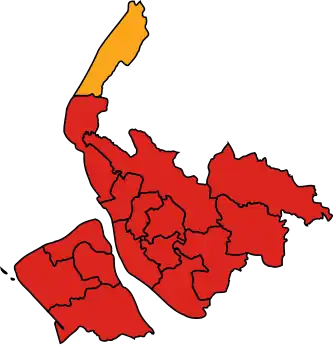 1997
1997 2001
2001 2005
2005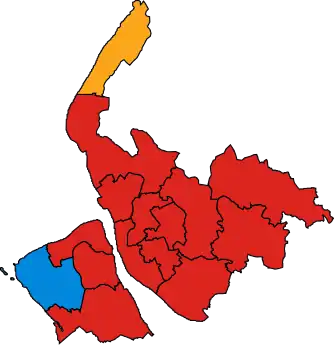 2010
2010 2015
2015 2017
2017 2019
2019
Historic representation by party
A cell marked → (with a different colour background to the preceding cell) indicates that the previous MP continued to sit under a new party name.
Birkenhead Social Justice Change UK Conservative Independent Labour Liberal Liberal Democrats
| Constituency | 1983 | 86 | 1987 | 88 | 90 | 90 | 91 | 1992 | 97 | 1997 | 2001 | 2005 | 07 | 2010 | 2015 | 2017 | 18 | 19 | 19 | 2019 |
|---|---|---|---|---|---|---|---|---|---|---|---|---|---|---|---|---|---|---|---|---|
| Knowsley South | Hughes | O'Hara | ||||||||||||||||||
| Birkenhead | Field | → | → | Whitley | ||||||||||||||||
| Bootle | Roberts | Carr | Benton | Dowd | ||||||||||||||||
| Knowsley North / and Sefton East (1997) / Knowsley (2010) | Kilroy-Silk | Howarth | ||||||||||||||||||
| Liverpool Garston / Garston & Halewood (2010) | Loyden | M. Eagle | ||||||||||||||||||
| Liverpool Riverside | Parry | Ellman | → | Johnson | ||||||||||||||||
| Liverpool Walton | Heffer | Kilfoyle | Rotheram | Carden | ||||||||||||||||
| Liverpool Broadgreen / Liverpool Wavertree (1997) | Fields | Kennedy | Berger | → | → | Barker | ||||||||||||||
| Liverpool West Derby | Wareing | → | Twigg | Byrne | ||||||||||||||||
| St Helens North | Evans | Watts | McGinn | |||||||||||||||||
| St Helens South / and Whiston (2010) | Bermingham | Woodward | Rimmer | |||||||||||||||||
| Wallasey | Chalker | A. Eagle | ||||||||||||||||||
| Wirral South | Porter | Chapman | McGovern | |||||||||||||||||
| Crosby / Sefton Central (2010) | Thornton | Curtis-Thomas | Esterson | |||||||||||||||||
| Wirral West | Hunt | Hesford | McVey | Greenwood | ||||||||||||||||
| Southport | Percival | Fearn | → | Banks | Fearn | Pugh | Moore | |||||||||||||
| Liverpool Mossley Hill | Alton | → | ||||||||||||||||||
See also
Notes
- BC denotes borough constituency, CC denotes county constituency.
- The majority is the number of votes the winning candidate receives more than their nearest rival.
References
- Baker, Carl; Uberoi, Elise; Cracknell, Richard (2020-01-28). "General Election 2019: full results and analysis". Cite journal requires
|journal=(help) - "Constituencies A-Z - Election 2019". BBC News. Retrieved 2020-04-24.
- "Update: Strengthening Democracy:Written statement - HCWS183". UK Parliament. Retrieved 2020-04-20.
- "Parliamentary Constituencies Act 2020".
- "2023 Review launched | Boundary Commission for England". Retrieved 2021-01-08.
- Watson, Christopher; Uberoi, Elise; Loft, Philip (17 April 2020). "General election results from 1918 to 2019".